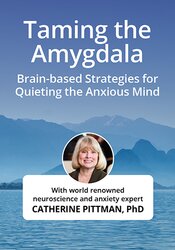

Neuroscience and anxiety expert Dr. Catherine Pittman shares essential keys for successful anxiety treatment: an understanding of how to calm and retrain the amygdala and an understanding of the influence of the cortex. She teaches strategies that are effective in calming the amygdala, techniques for teaching clients to retrain the amygdala’s response to triggers, and effective methods for reducing cortex-based activation of the amygdala. Her approach is rooted in neuroscience, but explained in ways that are accessible to all clients, regardless of educational background. Catherine’s approach promotes adherence to treatment and strengthens the therapeutic alliance, crucial aspects of treating anxious, worried, obsessive, or traumatized clients.
PESI Australia, in collaboration with PESI in the USA, offers quality online continuing professional development events from the leaders in the field at a standard recognized by professional associations including psychology, social work, occupational therapy, alcohol and drug professionals, counselling and psychotherapy. On completion of the training, a Professional Development Certificate is issued after the individual has answered and submitted a quiz and course evaluation. This program is worth 6.5 hours CPD for points calculation by your association.
| File type | File name | Number of pages | |
|---|---|---|---|
| Manual - Taming the Amygdala (5.7 MB) | 83 Pages | Available after Purchase |

Catherine Pittman, PhD, HSPP, is a professor of psychology at Saint Mary’s College, Notre Dame, Indiana. Dr. Pittman is the author of the popular books Rewire the Anxious Brain: How to Use the Neuroscience of Fear to End Anxiety, Panic, and Worry (New Harbinger Publications) and Taming Your Amygdala (PESI Publishing & Media). She has a background in cognitive behavioral therapy, neuropsychology, fear-conditioning research, and has treated anxiety-based disorders in clinical practice for over 25 years.
Dr. Pittman’s experience makes her uniquely qualified to provide a clear understanding of neuroscience and how that informs the selection and application of successful anxiety treatment strategies. She is recognized for her clear, accessible explanations of the role of the amygdala, and her approaches to lifestyle change and cognitive restructuring that help motivate clients to be more engaged and motivated in therapy. Dr. Pittman regularly presents workshops at national conferences and webinars on anxiety treatment and is an active member of the public education committee of the Anxiety and Depression Association of America.
Speaker Disclosures:
Financial: Dr. Catherine Pittman maintains a private practice and has an employment relationship with Saint Mary's College. She receives royalties as a published author. Dr. Pittman receives a speaking honorarium, recording, and book royalties from Psychotherapy Networker and PESI, Inc. She has no relevant financial relationships with ineligible organizations.
Non-financial: Dr. Catherine Pittman is a member of the Anxiety and Depression Association of America.
Key Knowledge about the Amygdala
Introducing Neuroscience Concepts
Promoting Motivation and Engagement
Identify Two Pathways to Anxiety
Client Friendly Explanations and Examples
Neuroplasticity in the Amygdala (Essential for all Anxiety Disorders, PTSD, OCD, Depression)
Through the Eyes of the Amygdala
Changing Client’s Relationship to the Amygdala
Relating Client Goals to the Amygdala
Exposure is Retraining the Amygdala
Relationship of Cortex to the Amygdala
Cortex-focused Interventions
Cognitive Approaches Target the Cortex
Please wait ...